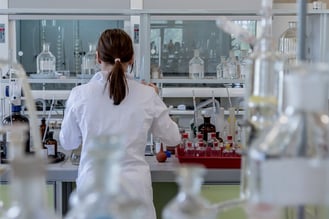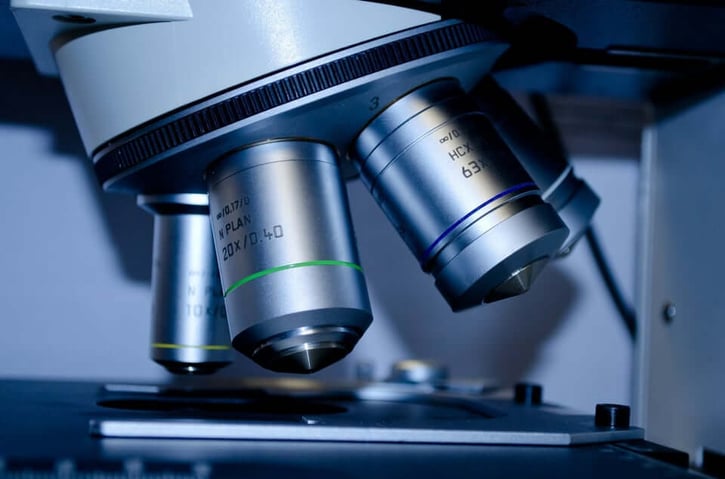As a recap on the first and second parts of this blog series on sampling, we’ve already covered; sampling strategy, taking a water sample and the chain of custody. In this final blog of the series, we will now outline some of the ‘mysteries’ of what happens once a sample is received by the test laboratory
Methods used for testing Legionella and other water samples.
The choice of the laboratory is important, and it should be UKAS accredited for each test method being carried out. Analysis should be undertaken following current ISO standard methods for the detection and enumeration of Legionella.
ISO 11731:2017 specifies culture methods for isolating Legionella and estimating their numbers in water samples. These methods apply to all kinds of water samples including potable, industrial, waste and natural waters.
Traditional methodologies for processing water samples.
Whilst there are many diagnostics available to a test laboratory, dependent upon the level of analyses required and the type of sample being processed, we will focus on the traditional microbiological methodologies for processing water samples and the associated benefits and limitations of these tests.
New (rapid) diagnostic technologies and the associated benefits of using such techniques will also be highlighted.
Traditional microbiology typically refers to the process of using selective agar to determine the presence of bacteria in each sample. Therefore, agar may be defined as a combination of nutrients required for a particular organism to grow.
 That said, some microorganisms (such as Legionella) are considered fastidious (fussy growers) even when attempted to be cultured on Legionella-selective agar, buffered charcoal yeast extract (BCYE) with cysteine, thus giving them the best chance to grow. This is a problem as other microorganisms (such as Pseudomonas aeruginosa) that are less fussy growers may inhibit Legionella's growth, which means that additional provisions are required to encourage the growth of the ‘target organism’, which is the one you want to grow.
That said, some microorganisms (such as Legionella) are considered fastidious (fussy growers) even when attempted to be cultured on Legionella-selective agar, buffered charcoal yeast extract (BCYE) with cysteine, thus giving them the best chance to grow. This is a problem as other microorganisms (such as Pseudomonas aeruginosa) that are less fussy growers may inhibit Legionella's growth, which means that additional provisions are required to encourage the growth of the ‘target organism’, which is the one you want to grow.
Such provisions require the use of glycine, vancomycin, polymyxin & cycloheximide (GVPC) agar as these ‘selective agents’ inhibit the growth of non-target organisms, thus assisting with the growth of Legionella bacteria (in accordance with ISO 11731:2017).
Those media have been refined over the years, but are still primarily selective for L. pneumophila, though other species can be isolated if enough colonies are selected for identification. A particular issue with these selective media is that they are not definitively selective, such that agar plates can be overgrown with other, faster-growing microorganisms which can obscure colonies of L. pneumophila if they are also present in the water sample that is being tested. This can be a particular problem when legionellae are only present in water samples only at low levels. The identification of single colonies may be difficult without a considerable amount of prior experience from the laboratory analyst. This creates the potential for a false-negative result being reported and therefore a false sense of confidence for the Water Safety Group charged with managing Legionella risk in a facility.
The isolation of legionellae from environmental samples can be particularly challenging because the bacteria may be present at low levels, requiring water samples to be filtered (or centrifuged) to concentrate the number of bacteria from the sample and improve recovery.
ISO 11731:2017 - Water quality — Enumeration of Legionella.
ISO 11731 references the use of the x3 plate method for the detection and enumeration (counting) of Legionella bacteria (this x3 plate method ensures the best chance of recovering this fastidious pathogen from water samples).
The x3 plate method requires samples to be directly plated onto selective agar, which is either untreated, treated with heat or treated with acid. These additional (heat and acid) treatments further inhibit the growth of non-target organisms thus helping to ensure a more accurate result. For this reason, the test laboratory of choice must be able to process such samples following this methodology.
What Happens Next?
Once samples have been plated, they are placed in an incubator at 36 +/- 2°C and checked 3 times with the final plate reading being on the 10th day of incubation. Therefore, from the day the water sample is processed by the test laboratory, it may take up to 2 weeks to receive a ‘positive Legionella result’, the time taken to report highlights the main limitation of this test method.
You can now appreciate why it takes time for the laboratory to report your final results!
PCR-based methods – Pros / Cons
 As we have a duty of care to ensure that individuals are protected from such waterborne pathogens, this has given rise to new technologies which aim to deliver faster results than those obtained through traditional methods. That said, many new technologies have been centred on using a molecular process known as polymerase chain reaction (PCR) and whilst it’s unequivocal that these diagnostics may provide results in a fraction of the time taken by traditional tests, they’re still not without limitations.
As we have a duty of care to ensure that individuals are protected from such waterborne pathogens, this has given rise to new technologies which aim to deliver faster results than those obtained through traditional methods. That said, many new technologies have been centred on using a molecular process known as polymerase chain reaction (PCR) and whilst it’s unequivocal that these diagnostics may provide results in a fraction of the time taken by traditional tests, they’re still not without limitations.
The additional benefits of using rapid diagnostics - that utilise PCR for example are that these diagnostics often have a ‘negative predictive value’ (NPV) of 100% which means that this test will correctly identify a negative test result 100% of the time.
Therefore, due to the high sensitivity of this test method, there is no chance of receiving a false negative test result. This however can be considered a ‘double-edged sword’ as whilst it’s very appealing to be using a test that will always report a negative result correctly, PCR-based methods have been traditionally poor at discriminating between living and dead bacterial cells, but modern test methods are available that remove dead cells from the sample , so whilst the NPV may be 100%, the chance of reporting false positive results may be quite high from previously affected water systems and especially from systems that have been recently disinfected - following chemical, thermal disinfection etc.
Some PCR-based tech utilises pre-filtration stages which aim to mitigate this by only capturing viable cells that will be used in the molecular stage of the test. Historically there may have been concerns about whether PCR reports are viable but non-culturable bacterial cells or whether the tech is reporting a combination of living and dead cells due to its limitations with discriminating between the two. That said, the tech is now available to discriminate between living and dead cells.
The other issue with utilising PCR-based technology is that test results are reported in ‘genomic units’ (GU) rather than colony-forming units (CFU) (as detailed in HSG274 part 2). Therefore, as the action limits for organisms like Legionella are reported in CFU/L, then one must question the relevance of counting GU/L (known as quantitative PCR or qPCR). In some test methods this may be an issue, but there is at least one company that has overcome this issue.
In summary, whilst PCR-based technology undoubtedly has its limitations there are PCR methods that overcome some or all of these limitations. At present, the speed and sensitivity of test results generated (in respect of selecting for pathogens like Legionella) should not be ignored and whilst qPCR may also have limited value at present, the technology and methodology is progressing and will no doubt improve. PCR can still be used as a useful ‘screening tool’ on previously unaffected systems – where detecting the ‘presence’ of an organism is good enough and where many samples require processing quickly.
Conclusion
Following such screening, traditional test methods (plating and colony counting) may then be used to complete ‘confirmatory’ works – where samples have tested ‘positive’ for the target organism! Therefore, using a combination of PCR-based methods and traditional testing may form the ‘blueprint’ for the best way forward with regard to microbiological test work.
PCR has now been around for several decades and has been proposed as the definitive assay that will provide answers to the key questions about the presence of Legionella in water samples and was projected to become the dominant test. To date, this has not happened, and the plate culture assay is still the historically accepted method of choice. Not all water laboratories have molecular microbiology facilities, equipment, financial resources or trained staff for routine molecular analyses.
As rapid testing becomes more readily accessible in the future, we will continue to update on their developments through weekly blogs…
Read more> Awareness and pitfalls of rapid testing
Feel free to reach out if you have any questions about this blog or if you would like to consult with one of our experts for further advice on water hygiene.
Editor’s Note: The information provided in this blog is correct at the date of original publication – February 2023.
© Water Hygiene Centre 2023
Image by PublicDomainPictures from Pixabay









